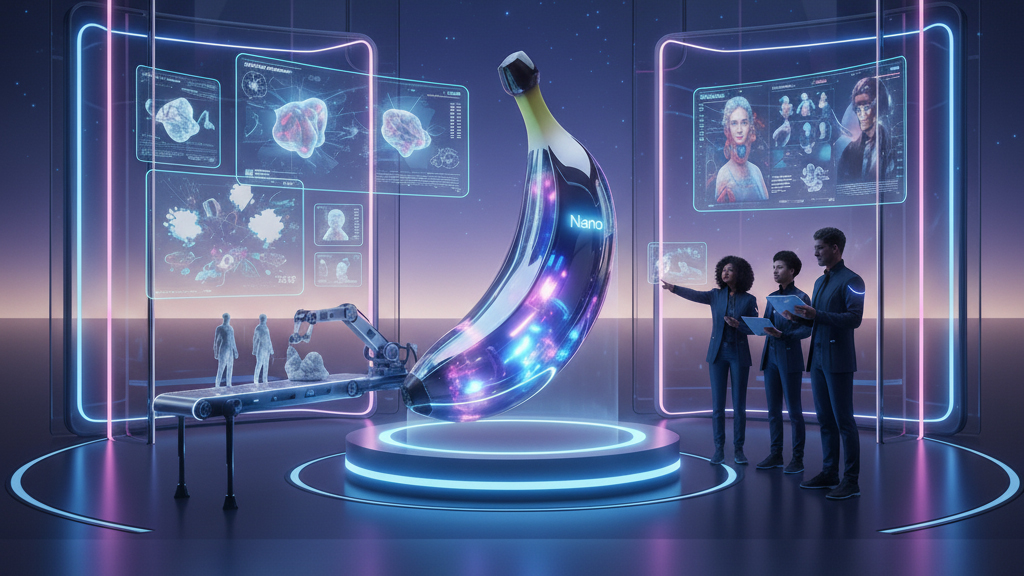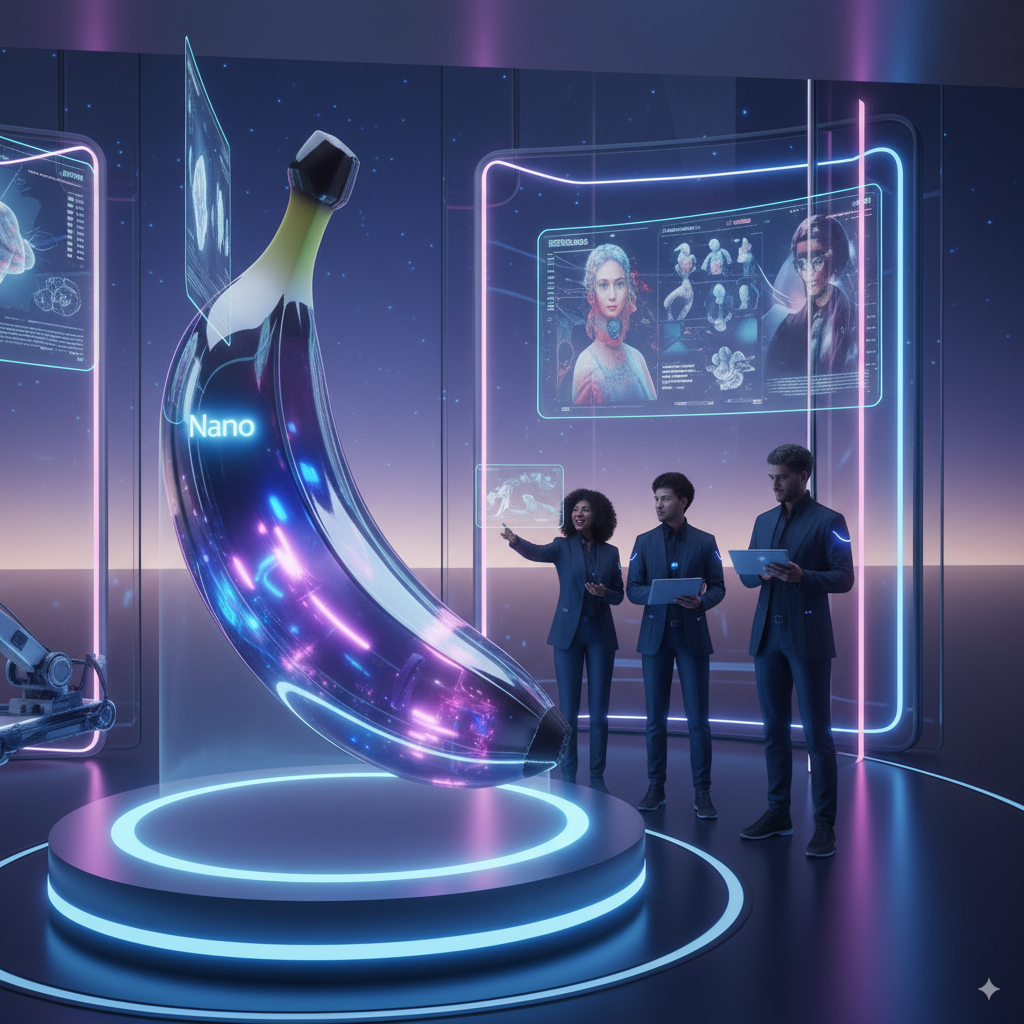(Before scrolling down, take a look at the hero image of this blog. Who made it? Your options are Midjourney, ChatGPT, Grok, Leonardo, or Nano Banana. Take a guess, and I’ll tell you at the end.)

What is Nano Banana?
Nano Banana is the unofficial name for Google Gemini’s new image generation and editing system, formally called Gemini 2.5 Flash Image. Released in August 2025, it is designed to handle both image creation from text prompts and precise editing of existing photos. Unlike earlier AI tools, Nano Banana emphasizes:
- Subject consistency: keeping faces, pets, and objects recognizable across edits.
- Editing flexibility: swapping backgrounds, changing clothing, or re-styling an image without distorting the original subject.
- Style blending: merging the look of one image with the content of another.
- Speed and accessibility: faster turnaround and simpler workflows than professional editing software.
This positions Nano Banana as a bridge between casual experimentation and professional-grade visual production.
Are you enjoying this content? Please sign up for my AI Newsletter or check out my Substack for more!
Who Should Try It?
Nano Banana has potential appeal across a wide range of users:
- Casual creators who want quick, shareable edits of their photos without learning complex tools.
- Influencers and content marketers who need a steady stream of distinctive visuals for platforms like Instagram or TikTok.
- Small businesses that want inexpensive product mockups, background swaps, or styled promotional images.
- Designers and concept artists looking for a faster way to prototype character designs, settings, or visual themes.
- Tech enthusiasts and hobbyists who enjoy experimenting with prompts and pushing AI creativity.
Why It Matters?
For people who haven’t explored AI image assistance, Nano Banana highlights why these systems are gaining traction:
- Ease of use: simple uploads and prompts lower the barrier to entry.
- Identity preservation: subjects remain consistent across multiple edits, which is critical for personal photos or branded assets.
- Creative flexibility: the model adapts to detailed instructions for lighting, style, and mood.
- Fast results: output is generated quickly enough to support iterative experimentation.
For many, this combination makes AI imagery less of a novelty and more of a practical creative tool.

Prompts That Are Driving Engagement
Nano Banana’s early success is tied to the prompts shared by users online. These examples illustrate both its range and its reliability.
- “Recreate this cat as a 16-bit video game character inside a 2D platform level.”
- Shared via Google Gemini Blog
- “Generate a photo of me as an adult sitting with myself as a child in a playroom having a tea party.”
- “Turn this photo into a map of a stylized 3D fantasy world, including a village and harbor.”
- “Transform this person into a traditional saree portrait, with a palace interior and cinematic soft lighting.”
- “Convert the photo into a pencil drawing.”
- Shared by JagranJosh
- “Make my pet into a plastic action figure next to its packaging.”
- “Generate a giant hyper-realistic statue of me, under construction with scaffolding, placed in a city roundabout.”
These prompts show how early adopters are using the model for both playful and emotionally resonant concepts, often with a high degree of detail.
How It Compares
Nano Banana is not the only AI image generator available. Here’s how it stacks up against several leading options:
MidJourney – https://www.midjourney.com/
- Strengths: unmatched for stylized and artistic generation, supported by an active community.
- Limitations: less effective at editing existing photos or maintaining subject consistency.
ChatGPT Image Tools – https://chatgpt.com/
- Strengths: tightly integrated into the ChatGPT interface; versatile for everyday creative tasks.
- Limitations: historically weaker at identity preservation in photo edits, though improving.
Grok4 – https://x.ai/news/grok-4
- Strengths: fast output with stylistic variety; integrated into X (Twitter) ecosystem.
- Limitations: less precision with complex edits and fine-detail realism.
Leonardo.ai – https://leonardo.ai/
- Strengths: strong for concept art, detailed textures, and style libraries.
- Limitations: editing real photographs can require extensive prompt work to maintain consistency.
Nano Banana’s Niche
Where Nano Banana differentiates itself is in photo editing and subject fidelity. While MidJourney may produce the most artistically striking images, Nano Banana is currently stronger for tasks like re-styling a portrait while keeping the subject recognizable.
Hero Image Showdown
The hero image of this post was made with AI. I gave the same prompt to Midjourney, ChatGPT, Grok, Leonardo, and Nano Banana. Which one do you think made it to the front of the blog page?
Here is the prompt:
A sleek, futuristic 3D render of a glowing banana-shaped AI device labeled subtly with “Nano.” The machine sits in a minimal, high-tech workspace with glass panels, neon light accents, and holographic screens displaying transformed images. Diverse creators stand nearby in stylish modern clothing, watching as the machine outputs photorealistic figurines and digital artworks. The scene is cinematic, polished, and editorial, with moody lighting and a clean abstract background. High-resolution, widescreen 16:9 ratio.
MidJourney

ChatGPT

Grok

Leonardo

Nano Banana

Key Takeaways
Nano Banana demonstrates that AI image generation is moving beyond novelty into practical creativity. Its strengths in identity preservation, blending, and editing make it appealing to both casual users and professionals looking for faster workflows.
It is unlikely to fully replace MidJourney’s artistry or Leonardo.ai’s versatility, but it offers a new standard for accessible, identity-aware editing. For those curious about AI image tools, Nano Banana is one of the most approachable and significant developments of 2025.